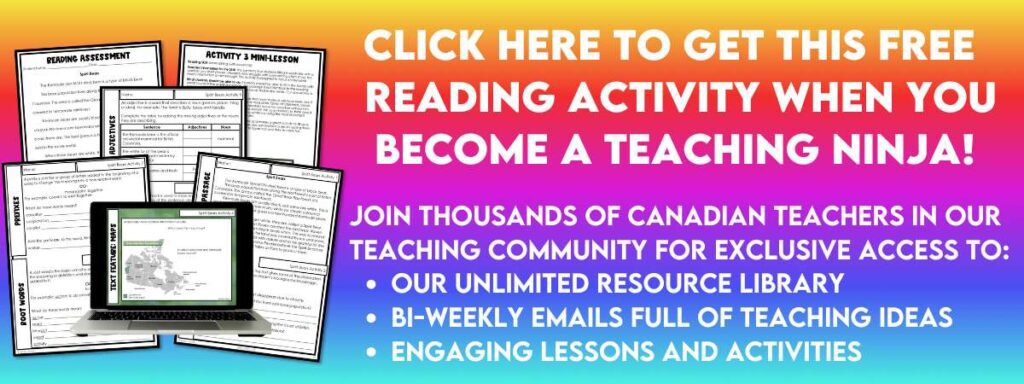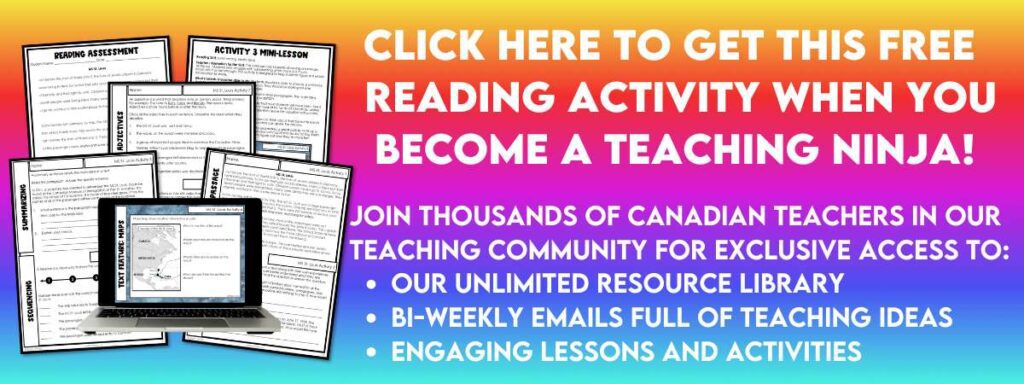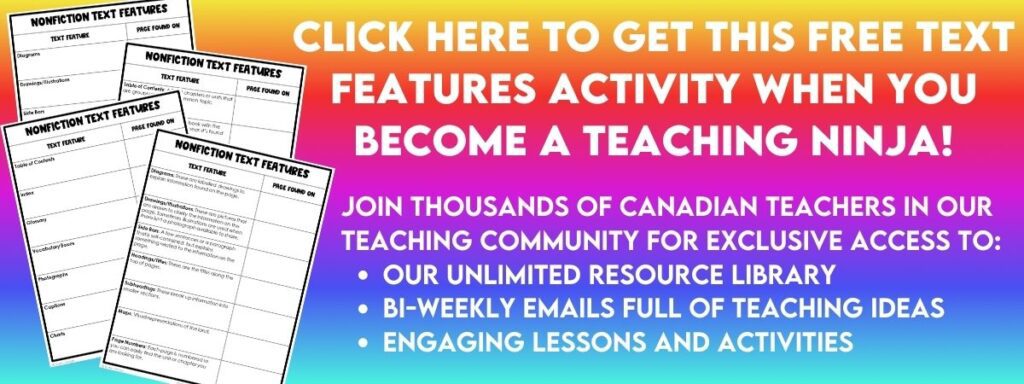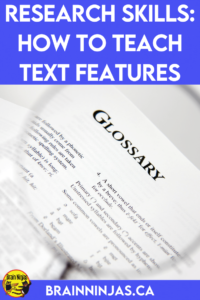
How often do you give your students a book and they can’t find any information in it? It seems if a page isn’t blinking and flashing they can’t seem to work it. Explicitly teaching text features can help your students understand how to process information better. This won’t just help with their reading, but it will help with all of their research, following directions and locating information quickly in all their subject areas.
Do Your Students Know About Text Features?
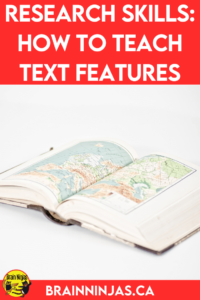
To be clear, when we are talking about text features, we are talking about things authors or editors do to organize informational writing. We often assume students know what we’re talking about when we ask them to look up something on the table of contents. Some students might not even know what that is.
When teaching text features use a book that’s already in your classroom and your students may need to use it throughout the year. We always use our social studies textbook for our example. You may need more than one book to show all of the different features.
We use nonfiction text features daily to teach our students. By understanding these text features, students begin to deepen their understanding while they are reading.
Nonfiction Reading
One way we explicitly teach text features is through our weekly reading comprehension activities. Find them on TpT ($USD) or our BN Shop ($CAN).
Each reading passage comes with several activities that specifically focus on different text features. You can try this set about Writing-On-Stone Provincial Park with your Grade 4 students. Find it on TpT ($USD) or our BN Shop ($CAN).
We also have a Grade 5 set about Permafrost. Find it on TpT ($USD) or our BN Shop ($CAN).
If you’re like another free set for Grade 4, we have this set about Spirit Bears in our Resource Library. We can also send it directly to your inbox when you join our email list.
And if you have Grade 5 students, this passage about Jewish passengers escaping Germany before World War 2 is available in our Resource Library. If you’re not already on our email list, we can send you this set about the MS St. Louis when you become a ninja.
Text Features to Teach Your Students

Table of Contents
This is a list of chapters or units that are grouped usually by a common topic. A list of page numbers accompanies the list. It is usually within the first few pages of a book.
Index
Found at the back of a book, this is a list of all topics in the book with the page numbers where they appear.
Glossary
This is a list of definitions for words (like a dictionary) found in the book. It’s usually near the back of the book. Words from this list are usually bolded in the text.
Vocabulary Boxes or Definition Boxes
When there is a challenging word on a page, it will sometimes be found along the side of the page in a box with a definition. These words are often bolded. Sometimes the words are also found in a glossary.
Photographs
These are real pictures found on the pages where the content relates. Since they are connected to the information on the page, they often come with a caption.
Captions
This is a small box of writing that explains the photograph, diagram or drawing that it is beside. Captions used for photographs often include who is in the picture, when it was taken, where it is located and what is happening.
Drawings, Illustrations and Diagrams
These are labelled drawings to explain information found on the page. They clarify the information on the page in a visual way. Sometimes illustrations are used when there isn’t a photograph available or when information needs to be simplified.
Side Bars and Textboxes
These can be found on an area of the page that is highlighted in another colour, shape or inside a box. They can be located anywhere on a page. These few sentences or paragraphs are self-contained meaning they can be read on their own). They usually explain something related to the information on the page but go into more detail about a specific topic.
Titles, Headings and Subheadings
These are the titles along the top of the pages. They are often bigger, bolder or found in a different colour to make them stand out. The biggest letters are the title. As each heading gets smaller, they are the details. Think of these as an outline. If you only read the headings and titles, you can find out whether or not the information is relevant to what you are looking for.
Maps
Visual representations of the land, populations, topography or geographical and political regions. Some maps show travelling routes, migration patterns or big areas (like Treaty Land or areas specific plants grow) in relation to other areas. Most maps will come with a legend, compass, title and sometimes a scale.
Charts and Graphs
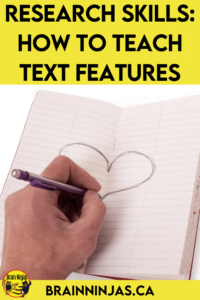
Sometimes information is put in a chart or a graph so it’s easier to compare the information. These can be tables, lists, pie charts, or bar graphs. Charts are a great way to share a lot of information in a small space.
Page Numbers
Each page is numbered so you can easily find the unit or chapter you are looking for.
Try This Text Features Activity
Give your students a nonfiction book along with a list of text features. Give students sticky notes and see how many of the different text features they can find. It doesn’t need to be a race, but putting a time limit on it makes it into a game. Allow students to use sticky notes to label the different text features on the pages in the book. Students could be searching in the same book if you have lots of copies or you can mix it up with different books.
If you’re a member of our free Resource Library page, you can get your own copy of the Text Features Activity. We can send you one directly to your inbox when you join our teaching ninja mailing list.
Text Features Save Time

Be sure to explain that when doing research, we don’t need to read the whole book. We need to quickly locate information related to what we are researching and only read the material about that topic. This means sometimes when we do research using books, we only look at a few pages in each book or skim-read to determine if the information on the page is relevant to our search.
Teaching text features is not a single lesson. Once you’ve taught the features once over with the whole class, talk about these features when you meet in your guided reading groups, when you’re modelling reading, when you’re sharing information and when your class is looking for information. The only way students will master text features is to make them feel comfortable by drilling them into their lovely brains.
Text features online are different, but if you’re doing research online with your students this post might be helpful How to Teach Research Skills With Google Search.
Are you looking for other Language Arts ideas?
- Give Your Reading Instruction an Easy Twist
- How to Teach Reading With Book Clubs
- Use Google Meet to Run a Book Club
- How to Celebrate Poem in Your Pocket Day
- Strategies for Reluctant Readers
- Help! I Don’t Know How to Do Guided Reading
- Help! What Do the Other Kids Do During Guided Reading?
- Preparing For Guided Reading Groups
- How to Run Your Guided Reading Instruction
- Add Great Content to Your Literacy Lessons
- How to Set Up Your Reading Comprehension Schedule
- Challenge Your Students with Writing Activities Every Day
- 22 Amazing Ways to Use Word Wall Words
- How to Include Different Types of Writing in Your Classroom
- Disguise Research Skills as a Scavenger Hunt
What activities do you like to do with your students to help them master text features? Share your thoughts with us in the comments below.

